Day 1 of a three day Private Tour. We spent today in North Norfolk. It was a cloudy start, brightening up through the day and sunny later, with a a very strong and blustery wind, gusting as high as 48mph.
To start the day, we headed inland to look for farmland birds. As we drove along, a couple of partridges ran across the road in front of us and, once we got closer, we could see they were Grey Partridges. The male stood for a second or two in the road before following the female into the hedge on the other side.
A Barn Owl was still out hunting, circling around a field behind a hedge, so we could just see it through the gaps. It was wet and windy last night, so presumably it was having to continue hunting to feed a hungry brood. We saw a couple of Red Kites on our journey, hanging effortlessly in the stiff breeze over the fields beside the road.
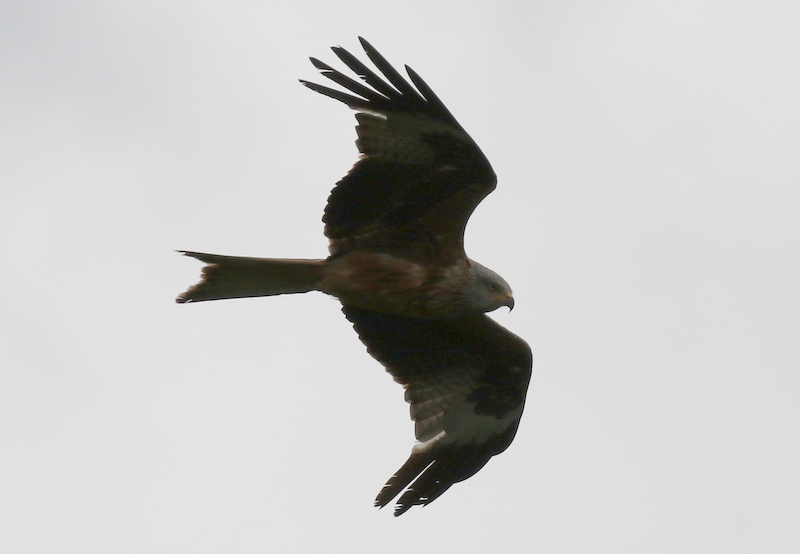 Red Kite – we saw a couple on our journey this morning
Red Kite – we saw a couple on our journey this morning
We stopped by a farm track and walked up to a point from which we could get a good view over the surrounding fields. A pair of Yellowhammers flew off from the track as we walked up. A couple of Skylarks were singing over the fields and a Common Whitethroat was singing in the hedge.
Raptors were a target here, but we thought it might be a bit too windy this morning. As it started to warm up, we could see several Common Buzzards circling up over the trees – it certainly didn’t seem to put them off. So too a Kestrel, which zoomed back and forth over a field. There were other things to see here too – a Green Woodpecker flew across in front of us, and a little later went back the other way, presumably nesting in one of the woods nearby. A pair of Mistle Thrushes did the same. We could see a swarm of House Martins feeding in the lee of some trees in the distance.
After watching from here for a while, we headed back to the car. It was nice to get out of the wind and we set off towards Titchwell where we planned to spend a few hours exploring the reserve. A brief stop by another set aside field on the way yielded very nice views of Brown Hare, hunkered down against the wind, plus a pair of nesting Oystercatcher, a Pied Wagtail and several Red-legged Partridges, quite an eclectic mix.
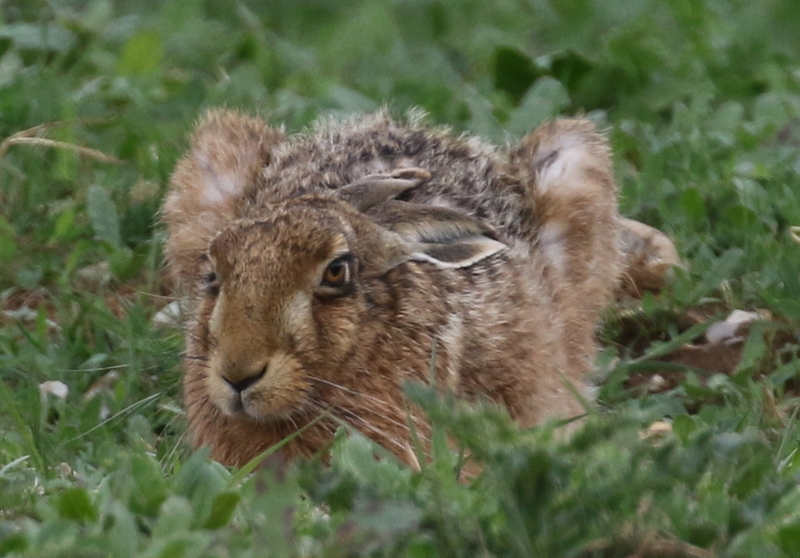 Brown Hare – hunkered down in a set aside field by the road
Brown Hare – hunkered down in a set aside field by the road
It was late morning by the time we got to Titchwell. We had a quick look round the car parks, but there was no sign of any Turtle Doves – it was rather exposed to the wind here. The field beyond held just a few Woodpigeons and Red-legged Partridges, plus a single Egyptian Goose in the paddocks beyond.
We had enough time to explore Fen Trail and out to Patsy’s Reedbed before lunch. On the walk down to the visitor centre, we heard first a Chiffchaff and then a Goldcrest singing, and saw the latter in a tree over the path right above our heads. Some Long-tailed Tits were calling from the sallows too.
Fen Trail was rather quiet – again it was rather windy here in the trees today – but there was more activity out at Patsy’s Reedbed. Just about the first bird we saw was a male Red-crested Pochard in the middle of the water, its coral red bill really shining in the sun. When a duller brown female flew in a little later and landed near the bank, he steamed straight over to her and the two of them started feeding together.
 Red-crested Pochard – this drake was on Patsy’s Reedbed
Red-crested Pochard – this drake was on Patsy’s Reedbed
The water was rather choppy and most of the other ducks were sleeping around the edge. There were quite a few Common Pochard and several Tufted Duck, plus the usual Mallard and Gadwall. There were a couple of smart Great Crested Grebes too and one of them gave us a nice flyby.
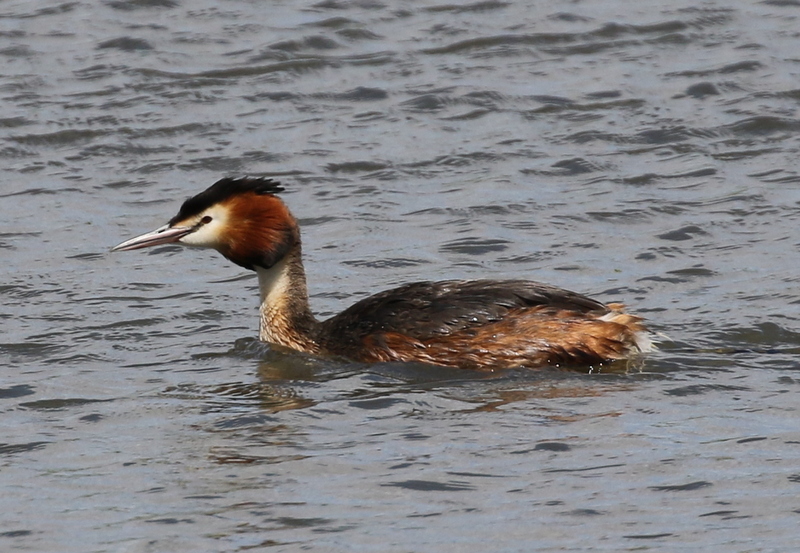 Great Crested Grebe – on Patsy’s Reedbed
Great Crested Grebe – on Patsy’s Reedbed
After lunch back in the picnic area, we set out along the main trail to explore the rest of the reserve. The Thornham grazing marsh ‘pool’ was very dry and pretty lifeless – apart from lots of Woodpigeons! The reedbed pool was rather quiet too today, perhaps because of the wind. We did see a Little Grebe on here and a Bearded Tit did a brief zoom across one way and then back the other shortly after.
Island Hide provided a welcome opportunity to get out of the wind and check out the freshmarsh. The first bird we picked up was a Little Tern, roosting on one of the islands. There were actually three on here today, with another pair resting further over, always great birds to see. There have been several Little Gulls here recently, all young 1st summer birds, and a scan of the freshmarsh confirmed that there were still three of those here too.
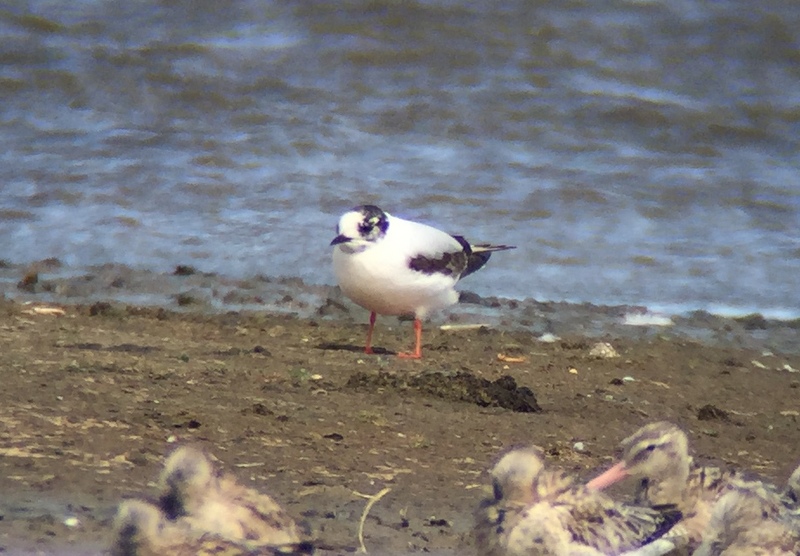 Little Gull – one of three on the freshmarsh today
Little Gull – one of three on the freshmarsh today
We watched the Little Gulls for a while, flying up into the wind, hanging in the air, and dip feeding in the shallow water behind one of the islands. Interestingly, there seems to be a turnover of different Little Gulls on the site, as the rather dark headed one we saw here a few days ago was not one of the three here today.
Early June is not the best time of year for waders, although it is only a matter of days before the first returning birds (of ‘autumn’?!) start to appear. There are plenty of the breeding waders here though, particularly Avocets, a small number of which had small juveniles scattered around the mud. There were a couple of Redshanks here too, though more of these are out on the saltmarsh.
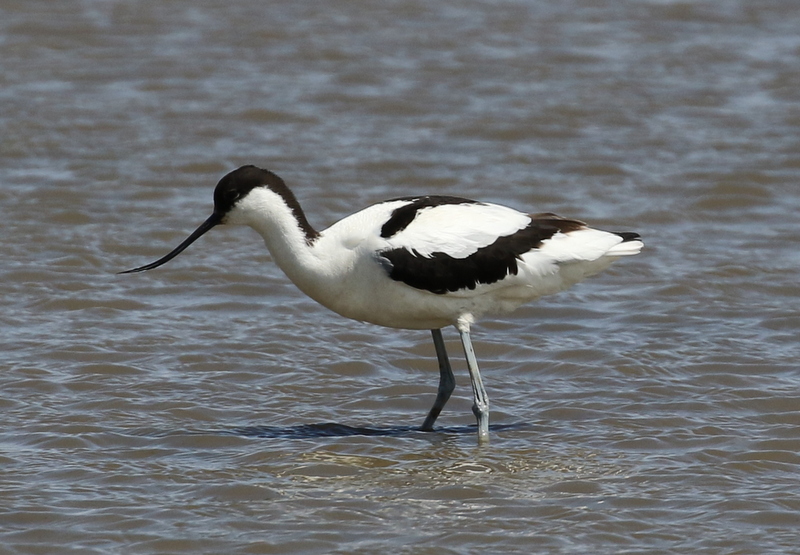 Avocet – always easy to see on the freshmarsh here at this time of year
Avocet – always easy to see on the freshmarsh here at this time of year
A group of non-breeding Black-tailed Godwits, most likely first summer birds, was sleeping on one of the islands and a larger group of Bar-tailed Godwits had probably fled the wind and tide out at the beach and was roosting in the shallow water. A lone male Ruff was out on the mud. This bird has been here for a while now, having moulted into summer plumage but not developed a distinctive ‘ruff’. It appears to have no intention of going north for the breeding season, again possibly a young 1st summer male.
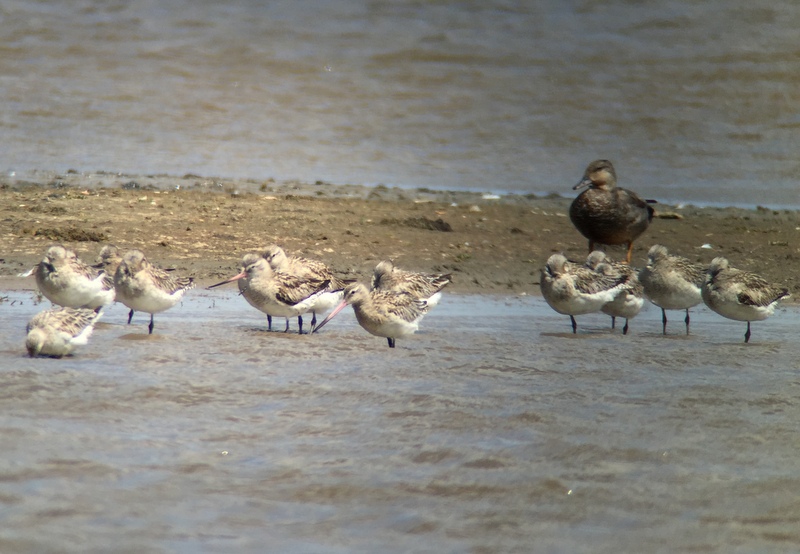 Bar-tailed Godwits – escaping the beach to roost on the Freshmarsh
Bar-tailed Godwits – escaping the beach to roost on the Freshmarsh
Summer is not the season for large flocks of dabbling ducks, with most of the wintering birds having gone north to breed. However, there are plenty of Shelduck and Gadwall here still, plus a few Shoveler. There were a few more Teal today, more than we have seen for a while, perhaps failed breeders or early moving drakes which have not come from so far away.
Braving the wind again, we made our way round to the shelter of Parrinder Hide next. The Little Gulls were a little closer from here, but we were looking into the sun which hindered our photographic efforts. We had a look at the fenced off island which now houses a sizeable colony of Black-headed Gulls. The vegetation is really growing up now, but we managed to get a look at two or three Mediterranean Gulls which are nesting in there too.
The tide was starting to come in again now and, coupled with the wind, was probably encouraging more waders to leave the beach. A small flock of Oystercatchers flew in and landed on the edge of the mud, bringing with them a single Turnstone. We decided to brave the beach ourselves, for a quick look at the sea.
There was almost nothing on Volunteer Marsh as we passed, just a few Avocets and Black-headed Gulls. Once we got out of the lee of the bank, it was very gusty out at the Tidal Pools. A small party of Turnstone flew in and tried to land in the vegetation at the back, while being buffeted by the wind. There were more Avocets here and several of these had small chicks. We watched a pair trying to lead their brood across a deep channel, with the fluffy juveniles swimming in the choppy water.
It was very windy out at the beach, and the sand was being blown across. With the tide coming in, there were very few birds here now. The sea itself was churning and very brown with sand, and there was next to nothing feeding offshore.
We walked back quickly to the comparative shelter of the bank and stopped to have a quick look at freshmarsh again. There were more waders on here now, in particular more Turnstones in with the Bar-tailed Godwits. A closer look revealed a party of five grey Knot with them too. The pair of Little Terns took off and flew past us, standing on the bank, disappearing out towards Thornham Harbour presumably to feed.
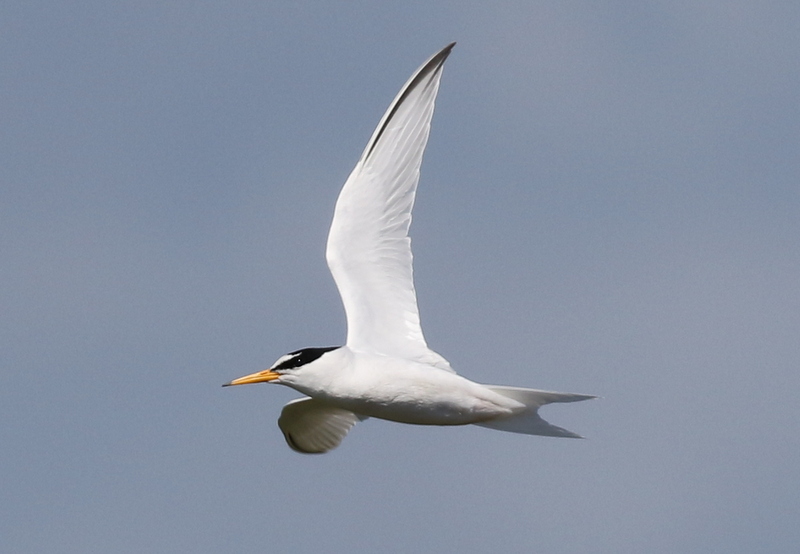 Little Tern – flew past us from the Freshmarsh out towards Thornham Harbour
Little Tern – flew past us from the Freshmarsh out towards Thornham Harbour
Back at the car, we started to make our way back east. We stopped at Holkham on the way, for a quick scan from the roadside. We could see several large white birds circling round over the trees. Spoonbills, possibly including some newly fledged juveniles making their first flights. A few more Spoonbills were perched in the trees below them, just visible through the scope.
A Great White Egret flew low across the grazing marshes and landed in the rushes out of view. A quick view, but always nice to see. A pair of Marsh Harriers were flying around over the field nearby, the male circling overhead, the female landing down in the grass below.
 Marsh Harrier – the male circling over in front of us
Marsh Harrier – the male circling over in front of us
The plan was to walk out from Lady Anne’s Drive, but when we got there the gate was closed. A parking attendant in a high viz jacket was standing nearby, so we stopped to ask what the problem was. We thought it was due to the building work going on there, but instead we were told it was due to the wind. ‘Health & Saftety guv’nor’ was the response, as he pointed to the trees. Falling branches or trees were conspicuous by their absence and the wind has been much stronger here without any problems, but this is typical of the culture we live in today. He directed us to Wells to walk in from there – neglecting to realise that this would mean walking through the pines!
A quick rethink, and we decided to head for Stiffkey Fen instead. A smart pale male Marsh Harrier was quartering over the field by the road as we parked. Blackcap and Chiffchaff were singing in the trees as we walked down the path. There had been rather few butterflies out today in the wind, but we started to see a few in the sunny sheltered spots along the hedgerows – Meadow Brown, Speckled Wood and Red Admiral.
 Meadow Brown – the highlight of the butterflies on a windy day
Meadow Brown – the highlight of the butterflies on a windy day
When we got to a point from which we could see over the brambles, we stopped to have a quick look out at the Fen. The first thing we saw was a Spoonbill. It was doing what Spoonbills like to do best, and fast asleep. Two Little Ringed Plovers were on the grassy edge of one of the islands. Otherwise, the water level on here was surprisingly high today, and the birds were dominated by lots of large gulls. A few Avocets appeared to be nesting still.
From up on the seawall, we had a better look over the Fen. Amongst the Herring Gulls, we could see several Lesser Black-backed Gulls and a couple of immature Great Black-backed Gulls. We could the distinctive call of Mediterranean Gulls and turned to watch as two smart adults flew in from the harbour. They were joined by a third, and all of them circled over the Fen calling for a minute or so, before disappearing off inland. A short while later, another two Mediterranean Gulls flew in, again both adults, and we got great views as they flew right past us.
 Mediterranean Gull – we saw several flying around the Fen today
Mediterranean Gull – we saw several flying around the Fen today
We had a quick look out at the harbour from the seawall. One of the seal boats flushed a Spoonbill from the far side, which flew across towards us before flying off west over the saltmarsh. It was an adult, so possible heading back to the colony at Holkham.We could see a few distant terns, with several Little Terns and Common Terns. One bird right over the far side looked more interesting – pale wing tips and rather long-tailed, possibly an Arctic Tern. We walked round to the edge of the harbour for a closer look.
There are not so many waders here at this time of year, but we did find two Bar-tailed Godwits with the large group of roosting Oystercatchers. There were two Ringed Plovers out on the mud at the near side of the harbour too. Two men were out walking their dog around the harbour, right out on the edge of the water. They flushed various birds as they went, but two terns which flew up looked like Arctic Terns. Unfortunately, they quickly landed again and didn’t come back up, so we couldn’t all get on them.
The afternoon was getting on now, and we had more to do this evening, so it was time to head for home.
One target for these three days was to look for for Nightjars, and tonight looked the best option in terms of weather. The wind seemed to be dropping as forecast early evening, but by 8.30pm it had picked up again. Still, it was not as windy as earlier, so we decided to give it a go anyway.
It was rather cool and breezy as we walked out over the heath. A Woodcock called – rather like a squeaky gate – and we watched as it flew along the edge of the trees, roding. A Tawny Owl hooted from the trees behind us. We positioned ourselves by a favoured Nightjar perch, and right on cue, one of the males called and then started churring. But at that point it started to spit with rain – this was definitely not in the forecast!
The other male Nightjars eventually started churring, and at one point we could hear three at same time on different sides of us, but after a few minutes two of them went quiet. One of the males normally comes in to the perch in front of us to churr at some point, but it became clear it was not coming in to its favoured post tonight. Perhaps it was the weather. We decided to walk across the heath to try to see one of the other churring males, but he too went quiet before we got there.
There was still one Nightjar churring in the distance and a second started up behind us, so we stood and listened to them for a couple of minutes. It is a great sound. Then we walked back to where we had been standing earlier. When we got back near the tree, we could hear wing clapping out over heather. The light was fading fast now, but we could just see a pair of Nightjars chasing around, the white flashes on the wings and tail of the male standing out in the gloom.
We walked down another path, thinking from the lower ground there we might be able to get them against the sky rather than the heather, but instead the Nightjars seemed to come in to investigate. The next thing we knew we had them circling round us, wing-clapping. Great stuff! We stood for a short while and watched them, before they disappeared back into the gloom, a nice way to end the day. It was getting rather dark now, so we made our way back.
















